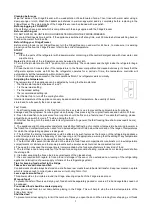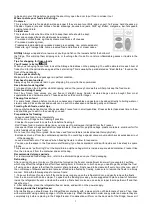
4
will normally run down the back wall and into the drain hole behind the salad bin.
The drain hole will have a “cleaning spike” inserted into it. This ensures that small pieces off food can not enter the drain.
After you have cleaned the inside of your Fridge and removed any food residues from around the whole, use the “cleaning
spike” to make sure that there are no blockages.
Cleaning outside the Fridge/Freezer
Use standard non-abrasive detergent diluted in warm water to clean the Fridge/Freezer exterior.
The grille of the condenser at the back of the Fridge/Freezer and the adjacent components can be vacuumed using a soft
brush attachment.
Do not use harsh cleaners, scouring pads or solvents to clean any part of the Fridge/Freezer
TROUBLESHOOTING AND MAINTENANCE
Trouble Shooting
Power cut
If the internal temperature of the Fridge/Freezer compartment is -18
℃
or less when the power returns, your food is safe.
The food in your Fridge/Freezer will remain frozen for approx 16 hours with the door closed. Do not open the
Fridge/Freezer door more than necessary.
The Fridge/Freezer is exceptionally cold
You may have accidentally adjusted the thermostat control dial to a higher position.
The Fridge/Freezer is exceptionally warm
The compressor may not be working. Turn the thermostat control dial to the maximum setting and wait a few minutes. If
there is no humming noise, it is not working. Contact the local store where your purchase was made.
The Fridge/Freezer is not working
Check it is plugged in and switched on. Check that the fuse in the plug has not blown. Plug
In another appliance, such as a lamp, to see if the socket is working. The Fridge/Freezer should be placed in a well
ventilated room. Leave the Fridge/Freezer for 30 minutes.
Condensation appears on the outside of the Fridge/Freezer
This may be due to a change in the room temperature. Wipe off any residue of moisture. If the problem continues contact
the local store where your purchase was made.
GURGLING, WHOOSHING
These noises are caused by the circulation of the refrigerant liquid in the cooling system. It has become more pronounced
since the introduction of CFC free gases. This is not a fault and will not affect the performance of your Fridge/Freezer.
HUMMING, PURRING OR PULSATING
This is the compressor motor working, as it pumps the refrigerant around the system.
Moving the Fridge/Freezer
Location
Do not place your Fridge/Freezer near a heat source, eg. Cooker, boiler or radiator. Also avoid direct sunlight in
out-buildings or sun lounges.
Leveling the Fridge/Freezer
Make sure the Fridge/Freezer is level. Use the rotating leveling feet at the front. If the Fridge/Freezer is not level, the
doors and magnetic seal alignments will be affected and may cause your Fridge/Freezer to work incorrectly.
Do not turn on the Fridge/Freezer for 4 hours
After the Fridge/Freezer is in place it needs to be left for 4 hours. This allows time for the coolant to settle.
Installation
Don’t cover or block the vents or grilles of your appliance.
NOTE: When the environment is high temperature and high humidity, if opening the refrigerator door too often,
there will be some frost at the back of fridge part(inside of refrigerator) and the water in water tray(located on top
of compressor) will overflow, This is not breakdowns. Please power off and clear the frost and water in time.
Vacation Time
•
Turn off the refrigerator first and then unplug the unit from the wall outlet.
•
Remove all the food.
•
Clean the refrigerator.
•
Leave the lid open slightly to avoid possible formation of condensation, mold, or odors.
•
Use extreme caution in the case of children. The unit should not be accessible to child’s play.
•
Short vacations: Leave the refrigerator operating during vacations of less than three weeks.
•
Long vacations: If the appliance will not be used for several months, remove all food and unplug the power cord.
Clean and dry the interior thoroughly. To prevent odor and mold growth, leave the door open slightly: blocking it
open if necessary or have the door removed.
How to save energy
01. Install the refrigerator in the coolest part of the room, out of direct sunlight and away from heating ducts or registers.
Do not place the refrigerator next to heat-producing appliances such as a range, oven or dishwasher.
02. The refrigerator door should remain open only as long as necessary; do not place hot food inside the refrigerator.
03. Organize the refrigerator to reduce door openings .Remove as many items as needed at one time and close the
door as soon as possible.
04. The refrigerator door should be properly closed to avoid increased energy consumption, and the formation of excess
ice and / or condensation inside.
05. Constantly circulating cold air keeps the temperature homogenous inside the refrigerator. For this reason, it is
important to properly distribute the food, to facilitate the flow of air.
06. Cover foods and wipe containers dry before placing them in the refrigerator. This cuts down on moisture build-up
inside the unit.
07. Do not overcrowd the refrigerator or block cold airvents. Doing so causes the refrigerator to run longer and use more
























